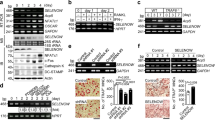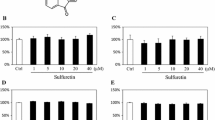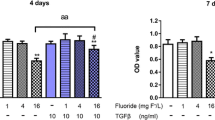Abstract
Bone is a passive storage organ for zinc, which contains about 30% of the total body zinc. However, during extreme zinc deficiency, only a small fraction of zinc is released in contrast to other tissues where zinc is released like monocytes or conserved, e.g., skeletal muscle. Zinc plays an important role in bone tissue remodeling. Zinc homeostasis is regulated by several zinc transporters (ZnTs) and importers (ZIPs), but their expression dynamics concerning zinc status of bone cells is not well understood. The study aimed to elucidate the effects of zinc supplementation and depletion on the transcript levels of various zinc transporters. Saos-2, a human osteoblastic cell line, was used as representative bone tissue. Zinc sulfate was used for simulating sufficient zinc status whereas TPEN, a zinc chelator, was used to simulate zinc-deficient state. Expression of various transcripts was measured by qRT-PCR. Subcellular localization of ZnT-1 was carried out by immunofluorescent microscopy, and Western Blotting was carried out to measure the expression of ZnT-1 at the protein level. Among the export transporters the transcript levels of MT, ZnT-1 showed higher levels in zinc sufficient and lower levels in TPEN treated cells. Expression of ZnT-4 was decreased under both the conditions. ZIP-6 and ZIP-13 were downregulated in zinc sufficiency, and ZIP-10 upregulated probably to prevent an excess zinc accumulation in bone cells. Further, ZnT-1 was found to be localized in the nuclear region of SaOS-2 cells. ZnT-1, ZnT-4, ZIP-6, ZIP-11, ZIP-10, and ZIP-13 along with MT may be responsible for maintaining bone zinc homeostasis.




Similar content being viewed by others
References
Andreini C, Banci L, Bertini I, Rosato A (2006) Counting the zinc-proteins encoded in the human genome. J Proteome Res 5(1):196–201. https://doi.org/10.1021/pr050361j
Prasad AS (1995) Zinc: an overview. Nutrition (Burbank, Los Angeles County, Calif) 11(1 Suppl):93–99
Jackson M (1989) Physiology of zinc: general aspects. In: Zinc in human biology Springer, pp 1–14
Hara T, Takeda TA, Takagishi T, Fukue K, Kambe T, Fukada T (2017) Physiological roles of zinc transporters: molecular and genetic importance in zinc homeostasis. J Physiol Sci : JPS 67(2):283–301. https://doi.org/10.1007/s12576-017-0521-4
Gunther V, Lindert U, Schaffner W (2012) The taste of heavy metals: gene regulation by MTF-1. Biochim Biophys Acta 1823(9):1416–1425. https://doi.org/10.1016/j.bbamcr.2012.01.005
Oner G, Bhaumick B, Bala RM (1984) Effect of zinc deficiency on serum somatomedin levels and skeletal growth in young rats. Endocrinology 114(5):1860–1863. https://doi.org/10.1210/endo-114-5-1860
Angus RM, Sambrook PN, Pocock NA, Eisman JA (1988) Dietary intake and bone mineral density. Bone Miner 4(3):265–277
Domenech E, Diaz-Gomez NM, Barroso F, Cortabarria C (2001) Zinc and perinatal growth. Early Hum Dev 65(Suppl):S111–S117
Yamaguchi M, Oishi H, Suketa Y (1987) Stimulatory effect of zinc on bone formation in tissue culture. Biochem Pharmacol 36(22):4007–4012
Diamond I, Hurley LS (1970) Histopathology of zinc-deficient fetal rats. J Nutr 100(3):325–329. https://doi.org/10.1093/jn/100.3.325
Ma ZJ, Shimanuki S, Igarashi A, Kawasaki Y, Yamaguchi M (2000) Preventive effect of dietary fermented soybean on bone loss in ovariectomized rats: enhancement with isoflavone and zinc supplementation. J Health Sci 46(4):263–268
Zhou JR, Canar MM, Erdman JW Jr (1993) Bone zinc is poorly released in young, growing rats fed marginally zinc-restricted diet. J Nutr 123(8):1383–1388
Nagata M, Lönnerdal B (2011) Role of zinc in cellular zinc trafficking and mineralization in a murine osteoblast-like cell line. J Nutr Biochem 22(2):172–178
Inoue K, Matsuda K, Itoh M, Kawaguchi H, Tomoike H, Aoyagi T, Nagai R, Hori M, Nakamura Y, Tanaka T (2002) Osteopenia and male-specific sudden cardiac death in mice lacking a zinc transporter gene, Znt5. Hum Mol Genet 11(15):1775–1784
Tibaduiza EC, Bobilya DJ (1996) Zinc transport across an endothelium includes vesicular cotransport with albumin. J Cell Physiol 167(3):539–547
Sreenivasulu K, Raghu P, Nair KM (2010) Polyphenol-rich beverages enhance zinc uptake and metallothionein expression in Caco-2 cells. J Food Sci 75(4):H123–H128
Cousins RJ, Blanchard RK, Popp MP, Liu L, Cao J, Moore JB, Green CL (2003) A global view of the selectivity of zinc deprivation and excess on genes expressed in human THP-1 mononuclear cells. Proc Natl Acad Sci 100(12):6952–6957
Hamon R, Homan CC, Tran HB, Mukaro VR, Lester SE, Roscioli E, Bosco MD, Murgia CM, Ackland ML, Jersmann HP (2014) Zinc and zinc transporters in macrophages and their roles in efferocytosis in COPD. PLoS One 9 (10):e110056
Moonga BS, Dempster DW (1995) Zinc is a potent inhibitor of osteoclastic bone resorption in vitro. J Bone Miner Res : Off J Am Soc Bone Miner Res 10(3):453–457. https://doi.org/10.1002/jbmr.5650100317
Yamaguchi M (2010) Role of nutritional zinc in the prevention of osteoporosis. Mol Cell Biochem 338(1–2):241–254. https://doi.org/10.1007/s11010-009-0358-0
Langmade SJ, Ravindra R, Daniels PJ, Andrews GK (2000) The transcription factor MTF-1 mediates metal regulation of the mouse ZnT1 gene. J Biol Chem 275(44):34803–34809
Suzuki T, Katsumata S, Matsuzaki H, Suzuki K (2016) A short-term zinc-deficient diet decreases bone formation through down-regulated BMP2 in rat bone. Biosci Biotechnol Biochem 80(7):1433–1435. https://doi.org/10.1080/09168451.2016.1153955
Palmiter RD, Findley SD (1995) Cloning and functional characterization of a mammalian zinc transporter that confers resistance to zinc. EMBO J 14(4):639–649
Dutta A, Sankavaram K, Chong L, Palermo A, Michel RG, Freake HC (2011) Rapid homeostatic response of h4iie cells to diethylenetriaminepentaacetic acid is not due to changes in the amount or localization of znt-1 protein. Nutr Res 31(5):404–411
Kelleher SL, Lonnerdal B (2003) Zn transporter levels and localization change throughout lactation in rat mammary gland and are regulated by Zn in mammary cells. J Nutr 133(11):3378–3385. https://doi.org/10.1093/jn/133.11.3378
Overbeck S, Uciechowski P, Ackland ML, Ford D, Rink L (2008) Intracellular zinc homeostasis in leukocyte subsets is regulated by different expression of zinc exporters ZnT-1 to ZnT-9. J Leukoc Biol 83(2):368–380
Lichten LA, Cousins RJ (2009) Mammalian zinc transporters: nutritional and physiologic regulation. Annu Rev Nutr 29:153–176. https://doi.org/10.1146/annurev-nutr-033009-083312
Huang L, Gitschier J (1997) A novel gene involved in zinc transport is deficient in the lethal milk mouse. Nat Genet 17(3):292–297. https://doi.org/10.1038/ng1197-292
Cerovic A, Miletic I, Sobajic S, Blagojevic D, Radusinovic M, El-Sohemy A (2007) Effects of zinc on the mineralization of bone nodules from human osteoblast-like cells. Biol Trace Elem Res 116(1):61–71. https://doi.org/10.1007/bf02685919
Yang J, Zhang Y, Cui X, Yao W, Yu X, Cen P, E Hodges S, E Fisher W, C Brunicardi F, Chen C (2013) Gene profile identifies zinc transporters differentially expressed in normal human organs and human pancreatic cancer. Curr Mol Med 13 (3):401–409
Smidt K, Pedersen SB, Brock B, Schmitz O, Fisker S, Bendix J, Wogensen L, Rungby J (2007) Zinc-transporter genes in human visceral and subcutaneous adipocytes: lean versus obese. Mol Cell Endocrinol 264(1–2):68–73
Sim DL, Chow VT (1999) The novel human HUEL (C4orf1) gene maps to chromosome 4p12–p13 and encodes a nuclear protein containing the nuclear receptor interaction motif. Genomics 59(2):224–233
Takagishi T, Hara T, Fukada T (2017) Recent advances in the role of SLC39A/ZIP zinc transporters in vivo. Int J Mol Sci 18(12):2708
Lichten LA, Ryu M-S, Guo L, Embury J, Cousins RJ (2011) MTF-1-mediated repression of the zinc transporter Zip10 is alleviated by zinc restriction. PLoS One 6(6):e21526
Sasaki S, Tsukamoto M, Saito M, Hojyo S, Fukada T, Takami M, Furuichi T (2018) Disruption of the mouse Slc39a14 gene encoding zinc transporter ZIP14 is associated with decreased bone mass, likely caused by enhanced bone resorption. FEBS open bio 8(4):655–663
Shumaker DK, Vann LR, Goldberg MW, Allen TD, Wilson KL (1998) TPEN, a Zn2+/Fe2+ chelator with low affinity for Ca2+, inhibits lamin assembly, destabilizes nuclear architecture and may independently protect nuclei from apoptosis in vitro. Cell Calcium 23(2–3):151–164
Acknowledgments
We are thankful to Dr. Bala Krishna, scientist ‘F’, National Institute of Nutrition, Hyderabad, India, for helping us in the statistical analysis.
Funding
Mr. Kiran Alluri received financial assistance from CSIR-New Delhi, India, as JRF and SRF (09/484/(0050)/2012-EMR-1). This research was funded by intramural grants to KPMN and partly by a grant to SG (5/9/1137/2014-NUT) from Indian Council of Medical Research, India.
Author information
Authors and Affiliations
Corresponding authors
Ethics declarations
Conflict of Interest
The authors declare that they have no conflict of interest.
Additional information
Publisher’s Note
Springer Nature remains neutral with regard to jurisdictional claims in published maps and institutional affiliations.
Rights and permissions
About this article
Cite this article
Alluri, K., Nair, K.P.M., Kotturu, S.K. et al. Transcriptional Regulation of Zinc Transporters in Human Osteogenic Sarcoma (Saos-2) Cells to Zinc Supplementation and Zinc Depletion. Biol Trace Elem Res 194, 360–367 (2020). https://doi.org/10.1007/s12011-019-01807-2
Received:
Accepted:
Published:
Issue Date:
DOI: https://doi.org/10.1007/s12011-019-01807-2




